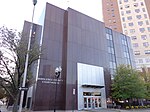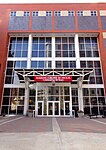Mason Gross School of the Arts is the arts conservatory at Rutgers University in New Brunswick, New Jersey. It is named for Mason W. Gross, the sixteenth president of Rutgers. Mason Gross offers the Bachelor of Fine Arts in Dance, Theater, Digital Filmmaking, and Visual Arts, Bachelor of Music, Master of Fine Arts in Theater and Visual Arts, Master of Education in Dance, Master of Music, Doctor of Musical Arts, Artist Diploma in Music, and MA and Ph.D. in composition, theory, and musicology. Mason Gross recently introduced a new program in the Visual Arts that offers a Bachelor of Design.
Mason Gross was founded in 1976 as a school of the fine and performing arts within Rutgers University and in 1976 became a separate degree-granting institution from the other Undergraduate colleges.
All fine arts departments at the other Rutgers colleges were merged into Mason Gross in 1981 and as of 2005 has expanded to more than 20 buildings, including the spacious visual arts studios at the Livingston campus and the Civic Square Building in the center of New Brunswick and a variety of performing-arts spaces. The buildings are all situated within Rutgers' Douglass College campus with the exception of the Civic Square Building (on Livingston Avenue) in the city's Civic Square government and theatre district and the sculpture facilities (on the Livingston campus).
Theater actor, director, and playwright Jack Bettenbender served as first dean of the school, from 1976 until his death in 1988. Bettenbender directed hundreds of theatrical productions, both at Rutgers and in New York City. An outdoor space dedicated in 2002 to honor John Bettenbender, the founding dean of the Mason Gross School of the Arts. The square is a gathering spot for students between classes, the site of impromptu performances and a summer setting for evening events. Avery Brooks gave the dedication eulogy.
Bettenbender Plaza
Bettenbender Plaza sits in front of Nicholas Music Hall, the performing arts center of Rutgers University, New Brunswick. The challenge was to design a plaza that would complement the theater’s activities as well as act as a gateway to the university.
The Blanche and Irving Laurie Music Library houses approximately 15,000 recordings and 30,000 monographs and scores, serving as a research and reference library at all levels. Studios and stages for the school will be located in the New Brunswick Performing Arts Center upon completion in 2019.
The Mason Gross School of the Arts has more than 500 events taking place annually on campus, alongside classes, rehearsals and numerous recreational activities.
Has an 18% application acceptance rate.











